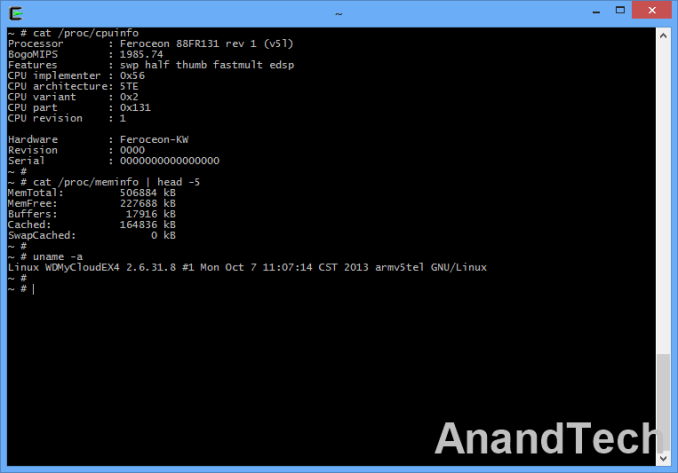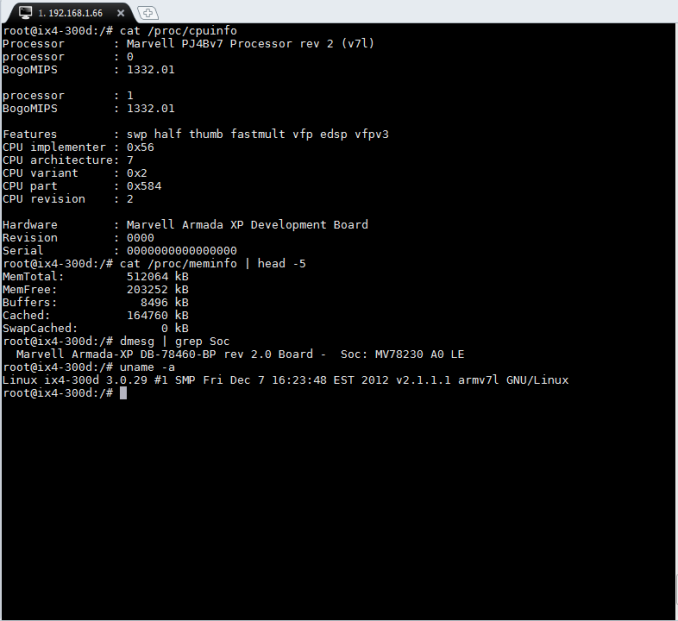Western Digital My Cloud EX4 and LenovoEMC ix4-300d Home NAS Units Review
by Ganesh T S on February 26, 2014 2:30 AM EST- Posted in
- NAS
- Western Digital
- LenovoEMC
Setup Impressions and OS Features
The ix4-300d and the EX4 were both easy to set up. Some of the NAS units that we have evaluated do not obtain a DHCP address and present a default web UI automatically (forcing the use of 'discovery applications'). The ix4-300d and EX4 both presented web UIs even in diskless mode. For the non-tech-savvy consumers, discovery applications are also provided.
Setting up the ix4-300d
On the very first page in the setup process, we have the ix4-300d's LifeLine OS offering a way to set up the 'Personal Cloud' feature. It basically creates a dynamic DNS entry (myiomegacloud.com) for the NAS, but requires port forwarding to be configured on the router. LenovoEMC's personal cloud feature allows for users to be invited to access configured shares. With firmware updates, they have also been adding support for access to multiple cloud services (such as Amazon S3, Mozy, Atmos etc.).
The ix4-300d also allows installation of apps from lifelineapps.com : The range and number of apps available is quite limited compared to other NAS units with third-party app support (such as QNAP, Synology and Asustor). Support for WOL (Wake-on-LAN) as well as allowing hard drives to go into idle is available in terms of energy conservation features. The System Status pages provide a way to monitor the CPU / drive temperatures, fan speed and board voltages. Backup jobs can be either 'rsync'-based 'Copy Jobs' or done to cloud storage. In terms of media features, we have a media server, torrent downloader and a Facebook / YouTube uploader available in the native firmware.
In terms of storage features, RAID migration and expansion worked without issues, but the UI is not very user friendly. We kept getting prompts to allow overwriting of disk data. The first time around, it was clear that only the data in the newly inserted disk needs to be deleted, but the second prompt was ambiguous (it is not clear whether the data in the new disk or the data in the currently existing volume was going to be overwritten). Sometimes, the prompt indicated that the unit couldn't use the new drive to expand / add to the storage pool, but the expansion process worked fine when the steps were retried (apparently, a result of using disks with existing partitions as the 'new' drives). This issue appears to be fixed in the latest firmware (4.0.8.23976) according to the release notes. In our testing, we were able to process all expansion steps without data loss, but LenovoEMC always suggests that data be backed-up prior to RAID expansions or rebuilds.
ix4-300d: Springing Surprises
LenovoEMC differentiates the px-series and ix-series based on more than just the base platform (x86 vs. ARM). There are a number of firmware / hardware limitations in the ix-series that may surprise regular observers of the SMB / SOHO NAS market:
- There is no support for hot-swap, which apparently adds a little bit to the cost of the platform
- The firmware doesn't allow multiple storage pools / volumes, i.e, all the disks have to be configured in a single storage pool as a single volume with one RAID type.
- The ix- series doesn't support for 2.5" drives
- The ix- series doesn't have support for encryption of volumes or shared folders
In addition to the above, LenovoEMC strongly advises use of disks with the same size in all the bays. Since there is no hot-swap, RAID migration and expansion have to be performed after switching off the unit and inserting the disks. The lack of hot-swap and absence of the ability to support disks with multiple sizes are the most disappointing amongst the features neutered for the ix4-300d compared to the corresponding 4-bay px-series NAS.
Unless a review is published to coincide with the product launch, we make sure to stress the product and also check out how the unit operates in the long term. Unfortunately, after a few months into the review process (by the time I was done with the initial back and forth with LenovoEMC), the unit started acting up strangely. After every 30 - 40 days, the NAS would become unresponsive (clients couldn't connect to the shares), and even the time reported on the front screen froze. SMB shares used to be the first to fail, and NFS shares remained accessible for some time before they failed too. There was no alternative but to do a hard power cycle. After the hard power cycle, the system would boot up, but the shares would disappear from the Shares view in the web UI. However the UI would allow the adding of a share with the same name as the pre-existing one, and the previously existing content could be found safe inside. There was no data loss, but the freezing experience would have been pretty scary if the unit had critical data stores inside. This symptom, apparently, was not restricted to our review unit alone. There are a few threads on LenovoEMC's support forums started by users with the same issue. For what it is worth, with the firmwares since the one released in November 2013 (4.0.6.19294), I haven't experienced this issue. However, the problem manifests infrequently. It is not clear if the issue has been really fixed (as there are no explicit mentions in the firmware release notes). For all we know, it could be a hardware issue with a particular batch of units, or some issue with the bundled drives (though they all had clean SMART reports).
Setting up the EX4
Moving on to the EX4, we find the UI to be more contemporary compared to the ix4-300d. A configurable dashboard on the web UI provides an overview of the device as soon as the user logs in. This includes NAS capacity, firmware version, resource usage, users and apps currently active on the unit.
The UI has a ribbon of options at the top. These include the capability to add users, configure shares, set up cloud access (wdmycloud.com) without the need for port forwarding and set up backup jobs. These backup jobs can be to an attached USB drive, a rsync-based remote backup, internally to a different volume or folder or to the cloud. Under the Storage menu, we have options to configure the RAID, disk status and iSCSI target configuration / target initiation. The Apps option lets users install third-party apps. While the selection isn't very extensive right now, it looks like Western Digital is on the right track by offering SDKs to third-party developers while also putting out a few applications on their own. The EX4 also provides advanced services such as DFS (Distributed File System) and Active Directory support. Various link aggregating modes are supported for the two network ports. ISO mounting, DLNA and iTunes servers round up the other features
In terms of RAID expansion and migration, the EX4 started off well. The current firmware supports JBOD to RAID1, JBOD to RAID 5 and RAID1 to RAID 5. However, RAID5 expansion (i.e, a 3 disk RAID-5 to 4 disk RAID-5) is not currently supported. Fortunately, RAID-5 rebuild (replacing a faulty disk in a 4-disk array) went smoothly. However, WD indicated that a fix for online RAID expansion would be made available soon. On the whole, except for the issue with the online RAID expansion, the reliability, wealth of features and ease of use of the EX4 give it a slight edge over the ix4-300d.
Shell Access
The ix4-300d and EX4 both provide SSH access. SSH access to the EX4 can be enabled via the settings page.
However, for the ix4-300d, things are a bit more complicated. SSH can only be enabled through a 'hidden' page which doesn't have any links from the main UI. Visiting http://<NAS IP>/manage/diagnostics.html leads to a support page which allows users to enable SSH access, generate and download debug logs and perform driver recover. (file system check / data reset). The username for SSH access happens to be root, and the password is soho followed by the admin password / root password set on the diagnostics page.
LenovoEMC makes it clear that enabling SSH (unless instructed by support personnel) and modifying the unit through that interface completely voids the warranty.



































38 Comments
View All Comments
Sorwis - Monday, March 3, 2014 - link
Torrent clients are included in many NAS/home servers. I think every single Buffalo model has it and it's wonderful. Nothing wrong with torrents even though they are widely used to obtain copyrighted material.Zepid - Sunday, March 9, 2014 - link
The 10 ten downloaded torrents last year were all legal, fyi.hoboville - Wednesday, February 26, 2014 - link
Using SSH on the Lenovo unit voids the warranty? Of all the...nubian1 - Wednesday, February 26, 2014 - link
I find reviews of NAS appliances very interesting. For the most part the majority of the available "Consumer Level" devices solidify my opinion that it's is better to build your own then to purchase a prepackaged device. Naturally this depends on the users tech level but honestly it isn't all that hard. Both on a performance and financial level, rolling your own more often than not will lead to better results. Rolling your own hardware combined with a great piece of software like FreeNAS, which btw is very extensible with plugins if needed, and you are off to the races at a cash outlay that will often be less than competing prepackaged devices and if the hardware is chosen correctly, better performance.demonbug - Wednesday, February 26, 2014 - link
18-20 watts at idle seems pretty high for what looks like pretty low-powered solutions; that's only a few watts less than the 6-bay Xeon-based NAS from Netgear you reviewed a while back. Considering that in a home environment it is going to be spending 99% of the time idle, it seems like keeping the idle power use down would be very important. That said, I'm not too familiar with NAS products - do they keep the disks spinning at idle?ganeshts - Wednesday, February 26, 2014 - link
The reported idle power is with 4 hard drives not fully spun down inside the NAS. The RN716 was idling with SSDs :)demonbug - Wednesday, February 26, 2014 - link
Ah, makes sense. Thanks for the reply.jardows2 - Wednesday, February 26, 2014 - link
This review makes me want to go price out building my own NAS. I do have a question though; What is the benefit of multiple NICs for a home NAS server? Link aggregation requires a special switch, and I cannot think that in a home/soho environment, network segregation would be needed. Failover redundancy could be a benefit, but I can't think of anything else.ganeshts - Wednesday, February 26, 2014 - link
Link-aggregation enabled switches can be had for less than $100 [ like this one : http://www.amazon.com/Netgear-GS108T-NAS-Prosafe-8... ]Multiple NICs can be useful if you are running a server backing up data from multiple machines in the household (I know of many who backup the PCs in their household everyday at 3 AM -- so that is all simultaneous traffic).
MTN Ranger - Wednesday, February 26, 2014 - link
How do these two NASs compare to a popular and similarly priced model like the Synology DS413j? For that matter, how about a review of the DS413j?